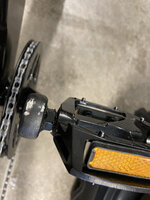I just got an Aventure and can confirm this is a real issue.
Coming from riding motorcycles, I'm used to leaning aggressively on turns. However, I found that even leaning slightly (at a roundabout, for example), causes the pedal to strike the ground. This is dangerous because if the strike is hard enough, it can cause the rear wheel to lift into the air and then it's game over at that point.
I'm training myself to keep pedals level horizontally during turns and using the throttle, but it'll take me a while to get used to it. I'm naturally inclined to pedal during turns to unload the front (like on a motorcycle) or to keep pedals aligned vertically (one pedal down, one pedal up). Both of these are problematic with this bike. I might have to look into those 152mm cranks like the guy in the video mentions, but it is annoying that I have to spend more money than I already did on the bike to address a basic safety issue.
Other than this, it is an amazing bike overall.

